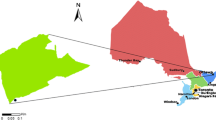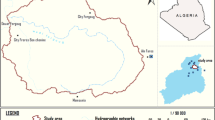Abstract
A series of computer programs designed to predict gross annual soil loss on a watershed basis by application of the Universal Soil Loss Equation (USLE) have been developed. The programs provide an easy-to-use, flexible, and standardized means of organizing base data and applying the USLE to large land areas. The programs can be used to assess and to evaluate the effects of changing land-use patterns and conservation practices on soil losses. Critical or problem areas can be readily identified. The USLE Computer Programs are a useful research tool for investigators involved in water quality management, 208 planning, or conservation research.
The package of computer programs consists of three main components: data input, the Main Program, and the Totals Program. Input data include both field base data describing the watershed and corresponding values for the factors in the USLE. The Main Program calculates the average rate of soil loss (tons/ acre/yr) and the total soil loss (tons/yr) for the smallest subunit of the watershed identified as the soil unit. Also calculated is an RKLS factor, which is an indication of the erosive potential of a given soil type, slope, and slope length, under a particular rainfall regime. The Totals Program aggregates soil unit losses into progressively larger units, that is, field, farm, subwatershed, and watershed units. An example of the programs' versatility and use is presented.
Similar content being viewed by others
Literature cited
Meyer, G. J., P. J. Schoeneberger, and J. H. Huddle. 1975. Sediment yields from roadsides: an application of the Universal Soil Loss Equation. J. Soil Water Conserv. 30(6):289–291.
Skopp, J., and T. C. Daniel. 1978. A review of sediment predictive techniques as viewed from the perspective of nonpoint pollution management. Environ. Mngmt. 2(1):39–53.
Stewart, B. A. 1975. Control of water pollution from cropland. USDA Rept. No. ARS-H-5-1. U.S. Dept. Agr., Hyattsville, Maryland. Vol. 1, 111 pp.
U.S. Congress (92nd). Senate. 1972. Federal Water Pollution Control Act Amendments of 1972. Public Law 92-500. s.2270. Washington D.C. 89 pp.
Wischmeier, W. H. 1974. New developments in estimating water erosion. Pages 179–186 in Land use: persuasion or regulation? Proc. 29th Ann. Meet. Soil Cons. Soc. Am. Ankeny, Iowa.
— 1975. Estimating potential erosion. Pages 7–25, III in B. A. Stewart, coordinator. Control of water pollution from cropland. (USDA Rept. No. ARS-H-5-1). U.S. Dept. of Agr., Hyattsville, Maryland. Vol. 1.
— 1976. Use and misuse of the Universal Soil Loss Equation. J. Soil Water Conserv. 32(1):5–9.
Wischmeier, W. H., and D. D. Smith. 1965. Predicting rainfallerosion losses from cropland east of the Rocky Mountains (Agr. Handbook No. 282). U.S. Dept. Agr., Washington D.C. 47 pp.
Wischmeier, W. H., C. B. Johnson, and B. V. Cross. 1971. A soil erodibility nomograph for farmland and construction sites. J. Soil Water Conserv. 26(5):189–193.
Author information
Authors and Affiliations
Rights and permissions
About this article
Cite this article
Miller, B.A., Daniel, T.C. & Berkowitz, S.J. Computer programs for calculating soil loss on a watershed basis. Environmental Management 3, 237–270 (1979). https://doi.org/10.1007/BF01866498
Issue Date:
DOI: https://doi.org/10.1007/BF01866498




